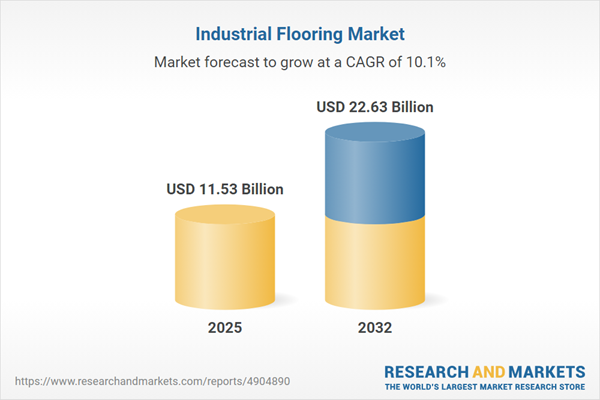Speak directly to the analyst to clarify any post sales queries you may have.
The industrial flooring market is rapidly transforming as businesses across manufacturing, logistics, and critical environments demand innovative solutions that optimize operational safety, efficiency, and compliance. Robust growth is forecast, driven by a combination of technological advancement, automation integration, and stringent sustainability mandates.
Market Snapshot: Industrial Flooring Market Size and CAGR
The Industrial Flooring Market grew from USD 10.45 billion in 2024 to USD 11.53 billion in 2025. It is expected to continue growing at a CAGR of 10.13%, reaching USD 22.63 billion by 2032. This positive trajectory highlights a sector underpinned by both technological innovation and evolving regulatory standards.
Scope & Segmentation
This report delivers in-depth analysis and market forecasts across critical segments, providing strategic clarity for senior leaders who need comprehensive insights into the industrial flooring ecosystem.
- Flooring Types: Anti-slip, anti-static, asphalt, concrete, epoxy, hybrid systems, polyurethane, thermoplastic, and vinyl flooring.
- Material Types: Asphalt, ceramics, concrete, resins, rubber, and thermoplastics.
- Layer Types: Multi-layer systems, roll-on coatings, self-leveling coatings, single-layer systems, and trowel-applied systems.
- End-Use Industries: Aerospace, automotive, chemical manufacturing, electronics and semiconductors, food and beverage processing, heavy manufacturing, oil and gas/petrochemicals, pharmaceuticals, warehousing, and distribution.
- Functions: Anti-slip/slip-resistant, anti-static/ESD, chemical-resistant, high-temperature resistant, hygienic/sterile, impact-resistant, and moisture barrier flooring.
- Regional Coverage: Americas (North and Latin America), Europe, Middle East & Africa, Asia-Pacific. Sub-regional analysis addresses the United States, Canada, Mexico, Brazil, Argentina, Chile, Colombia, Peru, United Kingdom, Germany, France, Russia, Italy, Spain, Netherlands, Sweden, Poland, Switzerland, United Arab Emirates, Saudi Arabia, Qatar, Turkey, Israel, South Africa, Nigeria, Egypt, Kenya, China, India, Japan, Australia, South Korea, Indonesia, Thailand, Malaysia, Singapore, and Taiwan.
- Key Players: Sika AG, RPM International Inc., MAPEI S.p.A., BASF SE, The Dow Chemical Company, The Sherwin-Williams Company, PPG Industries, Inc., Saint-Gobain S.A., Forbo International SA, and ARDEX GmbH.
Key Takeaways for Decision Makers
- Innovative polymer technology and advanced resin chemistries are enabling solutions that boost productivity and extend flooring service life in demanding environments.
- Sustainability trends, such as use of low-VOC materials and bio-based resins, are increasingly central to procurement and compliance strategies, affecting supplier selection and investment priorities.
- Digital floor monitoring, including sensors for integrity and slip resistance, supports predictive maintenance and drives new operational insights, especially in highly automated facilities.
- The rising adoption of specialist anti-slip and anti-static surfaces across sectors is closely tied to occupational safety requirements, especially where automation, robotics, and ESD control are critical.
- Customization of flooring for hygiene, chemical resistance, and load-bearing requirements is now essential in industries such as pharmaceuticals and food processing, redefining the competitive landscape.
- Regional expansion and strategic partnerships with local suppliers can mitigate risks from regulatory changes and shifting global trade dynamics.
Tariff Impact on Sourcing and Innovation
Recent United States tariffs on core raw materials, such as epoxy resins and thermoplastic polymers, are altering sourcing strategies for many manufacturers. The resulting shift to regional and domestic suppliers has catalyzed investments in local production and prompted research into bio-based and hybrid resin alternatives. These moves are part of broader efforts to build more resilient and cost-efficient supply chains, especially in light of ongoing pricing volatility. Facility managers and flooring contractors are actively renegotiating supplier agreements and prioritizing lifecycle cost analysis to secure continuity and manage risks from geopolitical fluctuations.
Methodology & Data Sources
This analysis employs a rigorous mixed-method approach combining both primary and secondary research. Expert interviews with chemical formulators, installation managers, and end users across key industries provide grounded perspectives on market needs, durability benchmarks, and innovation trends. Data triangulation ensures alignment with documented market movements and regulatory shifts, while site visits and in-field trials validate product performance in real-world operating conditions. Technical literature and proprietary databases further support comprehensive market assessment.
Why This Report Matters
- Strategic leaders receive actionable forecasts and segmented insights to guide capital allocation, supplier negotiations, and technology adoption within the industrial flooring market.
- Benchmarking against global and regional peers is enabled through detailed competitive profiling and analysis of innovation leadership.
- Procurement and operations teams can align floor system investments with broader sustainability, risk management, and regulatory compliance goals.
Conclusion
The industrial flooring sector is advancing through a convergence of material science, sustainability focus, and digital integration. Stakeholders who embrace these shifts, leverage regional partnerships, and prioritize adaptive strategies will be best positioned to meet evolving operational and compliance demands.
Additional Product Information:
- Purchase of this report includes 1 year online access with quarterly updates.
- This report can be updated on request. Please contact our Customer Experience team using the Ask a Question widget on our website.
Table of Contents
3. Executive Summary
4. Market Overview
7. Cumulative Impact of Artificial Intelligence 2025
List of Figures
Companies Mentioned
The companies profiled in this Industrial Flooring market report include:- Sika AG
- RPM International Inc.
- MAPEI S.p.A.
- BASF SE
- The Dow Chemical Company
- The Sherwin-Williams Company
- PPG Industries, Inc.
- Saint-Gobain S.A.
- Forbo International SA
- ARDEX GmbH
Table Information
| Report Attribute | Details |
|---|---|
| No. of Pages | 197 |
| Published | October 2025 |
| Forecast Period | 2025 - 2032 |
| Estimated Market Value ( USD | $ 11.53 Billion |
| Forecasted Market Value ( USD | $ 22.63 Billion |
| Compound Annual Growth Rate | 10.1% |
| Regions Covered | Global |
| No. of Companies Mentioned | 11 |









